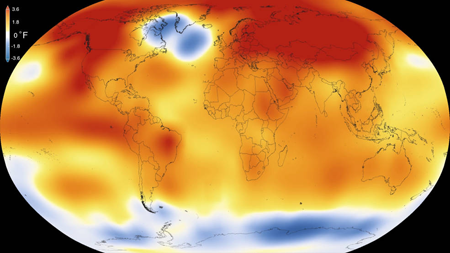Just a half degree of separation
A major global warming threshold is closer than it seems
Feb 9, 2016 - by Staff
The NSF NCAR Mesa Lab will be closed Wednesday, Dec. 17, 2025, due to a likely power shutoff.
View more information.Feb 9, 2016 - by Staff
February 9, 2016 | The planet is a lot closer to 2 degrees Celsius of warming than official temperature records indicate.
In 2015, the hottest year on record, the average annual temperature was a full 1 degree C (1.8 degrees Fahrenheit) warmer than in pre-industrial times. That’s halfway to the limit of 2 degrees C (3.6 degrees F) that world leaders set in Paris in December to prevent potentially catastrophic warming.
But what if we’re already effectively well beyond 1 degree C of warming?
The physics of Earth’s climate system means that warming continues long after greenhouse gases enter the atmosphere. That’s because the oceans continue to warm up for decades in response to greenhouse gases already in the atmosphere, creating a lag in the climate system.

2015 was the warmest year since modern record keeping began in 1880, according to an analysis by NASA’s Goddard Institute for Space Studies. This continues a long-term warming trend: 15 of the 16 warmest years on record have occurred since 2001. (Image courtesy of Scientific Visualization Studio/Goddard Space Flight Center.)
As a result, we’re committed to about 0.5 degrees C of additional warming even if we could immediately stabilize levels of carbon dioxide in the atmosphere, research has shown. The extra warming means that the planet is effectively three-quarters of the way to the 2-degree C target.
“The system will keep warming for a while even if greenhouse gas concentrations could suddenly freeze at current levels,” said NCAR senior scientist Jerry Meehl, who led a 2005 study into the additional warming. “So keeping within the 2-degree target is even harder to do because we not only have to stabilize concentrations but start to reduce them.”
Scientists refer to the continued warming as thermal inertia. It’s part of the reason that experts have warned that the emissions cuts proposed during the Paris negotiations, while critical for lessening future climate change, may not be sufficient.
Meehl and other scientists are studying a hypothetical scenario in which society later this century actually achieves “negative emissions”—drawing more carbon dioxide out of the atmosphere than is emitted into it. This would reduce concentrations and overcome the committed warming.
However, experts are uncertain whether such an approach is feasible since it would require massively scaling up existing technologies, such as using biological organisms to soak up carbon dioxide, or capturing carbon dioxide from power plant emissions and storing it underground.
“The scenarios that we’re running in climate models take into account the climate change we’re already committed to,” Meehl said. “One of those scenarios assumes negative emissions by about 2070, meaning we would be pulling more CO2 out of the air than we’re putting in.
“In order to stay within the 2-degree target, it’s important to start cutting emissions sooner rather than later,” he added, “because at some point the greenhouse gas concentrations will need to come down.”
Writer/contact
David Hosansky, Senior Science Writer and Media Relations Manager